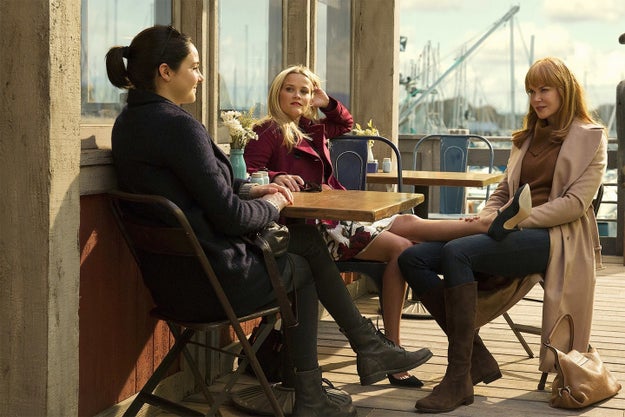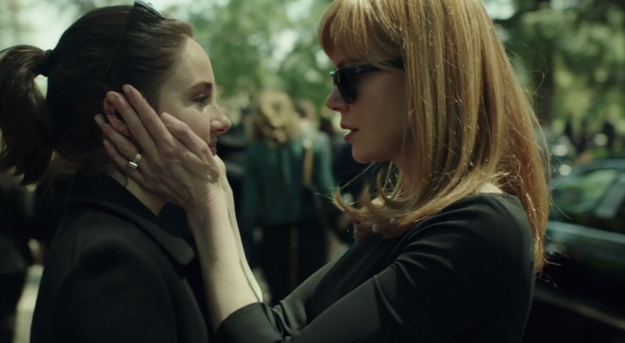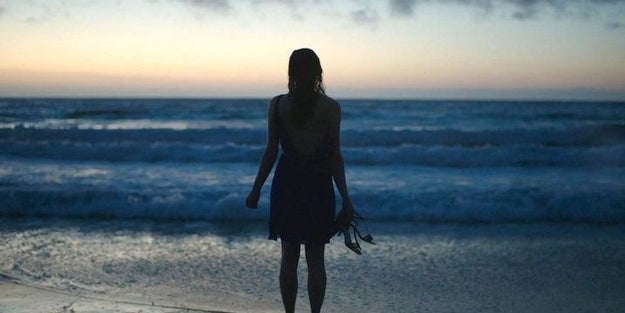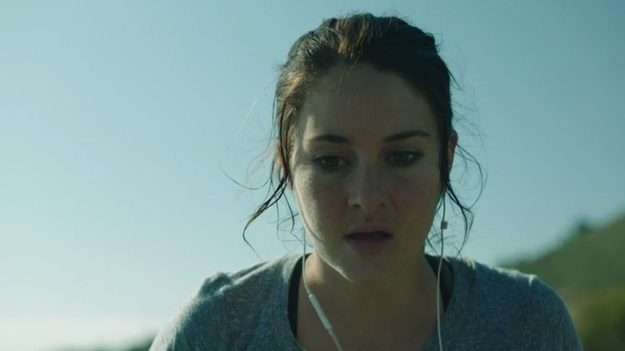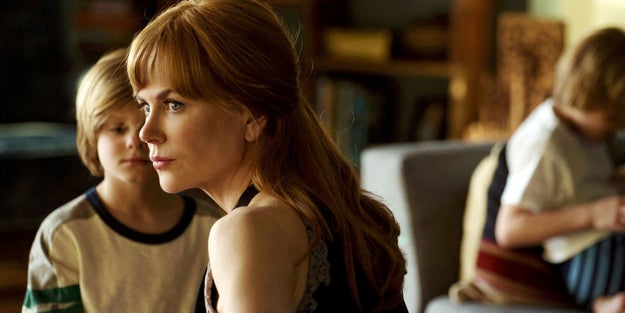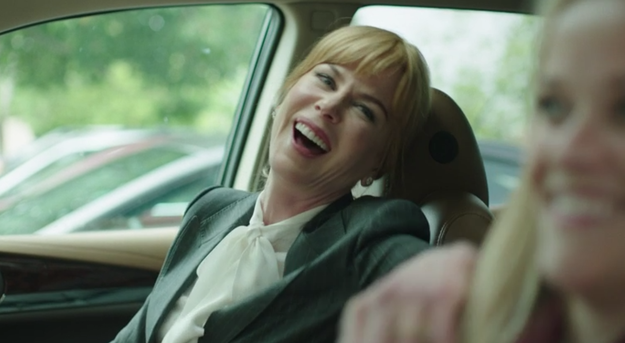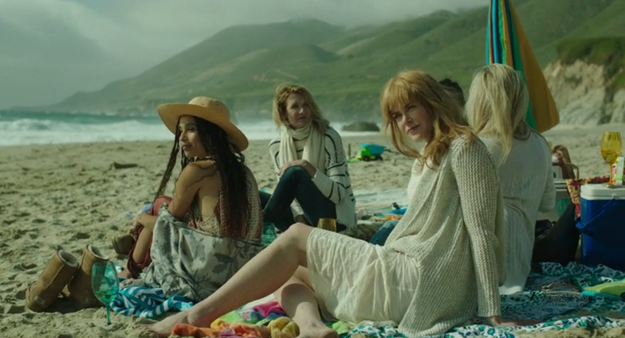
1. How it challenged our instincts about women on TV.
I’ve never seen anything like Big Little Lies on TV before. But prior to its premiere, I had at least three conversations with TV journalists who were dismissive of it because it was about a group of rich women. I was shocked — are the tribulations of women’s lives and motherhood fodder for a trove of TV shows hidden away from me somewhere? Because personally, I’m more tired by crime and conmen.
Prestige television as it currently exists has largely skipped over stories about communities of women — Desperate Housewives and Sex and the City addressed women’s problems and friendships early on in the new Golden Age of TV, and Orange Is the New Black and Jane the Virgin are still doing it. (Gilmore Girls, which was never considered Golden Age, is another exception.) But think of how rare it is to see a group of women in a scene talking about their lives. The stakes are so high on TV these days, almost no one talks about their lives! (The doctors on Grey’s Anatomy do sometimes, but then they’re inevitably interrupted by a surgical emergency.) Big Little Lies offered something different, as the final scene of the miniseries showed in almost comic relief. While the road to that frolicking-on-the-beach ending wasn’t a feminist utopia — there was sniping and competitiveness and jealousy along the way — it is possible for women to come together to try for something better. Or not, actually — I would also gladly watch shows about women coming together to try for something worse! —Kate Aurthur
2. Its acting.
One of my favorite parts of Big Little Lies is watching the characters listen while someone else is talking. It’s the kind of acting that’s usually thankless — all we tend to get is a quick shot of someone generically nodding their head.
On Big Little Lies, however, listening is such an integral part of the story. It matters how Madeline (Reese Witherspoon) absorbs Jane’s (Shailene Woodley) matter-of-fact explication of her rape; how Celeste (Nicole Kidman) takes in Perry’s (Alexander Skarsgård) careful elisions regarding his abuse in their first therapy session; and how Jane receives the child psychologist’s positive assessment of Ziggy (Iain Armitage). And in each of these scenes, Witherspoon, Kidman, and Woodley do some of the best work of their careers.
As does just about everyone else on this show! Adam Scott allows Madeline’s husband, Ed, to be wounded and prickly and kind of dull in the same moment, so you can understand why she would be drawn to him but not all that thrilled by him. Skarsgård somehow manages to keep Perry from becoming a two-dimensional villain without ever shying away from the monstrousness of his behavior. Even Zoë Kravitz is able to give shape to Bonnie, the character given the shortest shrift on the show, especially considering her all-too-relevant backstory in Liane Moriarty’s novel. (Spoiler alert for the book of the show you’ve already watched: Bonnie was abused by her father.)
And then there are the kids. All of them so kidlike in the most real way — I believe that Madeline’s daughter Chloe would be so self-possessed and musically astute because Darby Camp totally convinces me of these traits.
It will be fun, if a little reductive, to watch the Television Academy scramble to sort out how to nominate all of Big Little Lies’ superlative performances — the Leading Actress in a Limited Series category alone will be insane. For now, though, we can just revel in a show that allowed so many talented people so much room to breathe so much life into all of these messy, compelling, deeply human characters. —Adam B. Vary
3. How it nailed the insidious threat of men.
There’s something haunting about Big Little Lies, and it’s not just the fact that death hangs over the entire series. Its creeping feeling is palpable — and it hinges, at least in part, on the role of men in this series about women.
Though Big Little Lies is not about misogyny per se, there is an underlying sense of male threat embedded into its narrative — most dramatically in every scene between Celeste and Perry. But it’s also there when Ed’s eyes linger on his teenage stepdaughter Abigail (Kathryn Newton) — an action never spoken of or confronted — and when he watches Bonnie exercise, then comments that he “just love[s] sweat on women.” It’s there in the tenor of how Renata’s (Laura Dern) husband Gordon (Jeffrey Nordling) threatens Jane, and in the feeling of foreboding when Madeline’s ex-lover Joseph (Santiago Cabrera) screams at her, moving toward her in anger while they’re alone. It’s there when Madeline is alone in her car, breaking down in tears after hearing about Jane’s rape. It’s even there in the children: the way Renata and Gordon’s daughter Amabella (Ivy George) comes home with bite marks, but is too afraid to tell her parents who hurt her.
In big and little ways, Big Little Lies shows what so many women learn through experience. It’s not a problem that can really be solved in seven hourlong episodes of an HBO series, but the finale of Big Little Lies brings one of its driving themes together in a genuinely moving way: Throughout the episode, we see both the subtle and momentous moves women make for each other when they sense that something is, indeed, off. It’s in the way Madeline jumps in to defend Jane when Gordon confronts her, and in the body language between Renata and Celeste after the former witnesses the latter run from Perry. It’s in the way Bonnie follows Celeste with her eyes when she senses Perry is a threat. And it is, of course, in the literal manifestation of all of this tension, when Perry attacks his wife and all of the women come to her defense. Because while the show has fun with its wealthy helicopter moms, it comes alive through the shared language — and in this case, the eventual shared bond — that accompanies surviving the nagging threat of men. When we think about Big Little Lies years from now, we’ll see all of those women united on the beach — at least, I know I will. —Alanna Bennett
4. Its therapist.
My parents, now retired, spent much of their adult lives as mental health professionals (my mother was a clinical social worker; my father, a psychiatrist). Some of their patients were grappling with issues similar to what Celeste has to confront in Big Little Lies. But until “Once Bitten,” the episode in which Celeste’s therapist, Dr. Reisman (Robin Weigert), carefully guides her patient to face the truth of the abuse her husband Perry inflicts on her, I had never seen any TV show or movie so thoughtfully capture what my parents did every day in their offices.
Far too often, therapists are used as convenient tools for conflict, breaking ethical boundaries without a second thought and behaving wildly outside of the interests of their patients. I get it — that kind of depiction can make for easy drama. But like every other facet of Big Little Lies, in Celeste’s sessions with Dr. Reisman, this show chose instead to pursue the great drama of real human behavior. Even more than HBO’s late 2000s series In Treatment, this show nailed the empathic precision therapists employ to help their patients slowly, sometimes arduously, disentangle themselves from the thorny traumas weighing down their lives. I’ve never seen anything quite like it, and after that scene in “Once Bitten” was over, I was so overcome with emotion, I had to pause the show for a second to recover. —ABV
5. Its directing.
Between schoolyard politics, the tugs of trauma, and the emotional lives of a large cast of characters, Big Little Lies is a show that has a lot to juggle. It could have easily spun out into chaos in the hands of a less adept director. Under Jean-Marc Vallée, though, the pieces fall into a heartrending harmony.
If you’re a fan of Big Little Lies, do me a favor and watch (or rewatch) 2014’s Wild. Directed by Vallée and adapted from Cheryl Strayed’s memoir about a woman at an emotional crossroads, the film is a close sibling to the HBO series. In both, Vallée’s approach to memory — chopped up and lively through quick-cuts — pulls you into the void of the past, while simultaneously grounding you in the present. His work evokes the contemplative and the hungry, and it’s easy to see why Witherspoon — who is also one of Big Little Lies’ executive producers — was so eager to work with him a second time. The stunning visuals, incredible performances, the wit of it all, that music — the feel of the show is one of the many things that make it so magnetic.
Vallée was crucial in throwing it all in the same big pot and making it sing in a way that doesn’t just feel like a retread of the same fixtures we’ve seen on TV for years. —AB
6. Its music.
The music featured in Big Little Lies is impossible to ignore, and it completely took ahold of the show’s audience. The soundtrack doesn’t feature any original compositions, but the already famous sounds of Janis Joplin, Fleetwood Mac, and Alabama Shakes play in the background (and sometimes even the foreground) at the most relevant times.
The lyrics and melodies evoke a whole myriad of emotions: the theme song — “Cold Little Heart” by Michael Kiwanuka — sets an eerie, intriguing, and engaging tone; “River” by Leon Bridges plays through the car stereo when Madeline and Chloe are talking about forgiveness and “making up”; and Bonnie, Ed, and Nathan (James Tupper) all sing the tunes of Elvis at Trivia Night while so much other drama unfolds.
The music is almost another character on Big Little Lies, and it moves viewers to feel empathy, fear, and, eventually — when a cover of “You Can’t Always Get What You Want” plays in the final scene of Episode 7 as Celeste, Madeline, Jane, Bonnie, and Renata are all on a beach with their children — it brings a sense of peace. —Krystie Lee Yandoli
7. Its depiction of parents and children, and what they pick up on.
Throughout its seven episodes, Big Little Lies did a great job of capturing the absolutely crippling nature of violence, which is common throughout the series. It’s at its most extreme whenever Perry physically assaults Celeste, and we feel it in a gut-wrenching, ominous way when Ziggy is accused of hurting Amabella. What’s incredibly interesting about the latter is how it depicts children adapting to the things they have seen or heard or felt. Though Perry thinks he can hurt Celeste without anyone knowing, one of his own sons — which we find out in the show’s finale — has been the one harming Amabella all along. This, in turn, leads to the elementary school children — Ziggy, Amabella, Chloe, and Josh (Cameron Crovetti) — handling the assault of a classmate much like adults would on the series: by not saying anything about it at all. Or, worse yet, with Max (Nicholas Crovetti) becoming the aggressor himself.
The way adults speak to children in the series reminded me of a quote from Toni Morrison’s debut novel, The Bluest Eye: “Adults do not talk to us — they give us directions,” she wrote. “They issue orders without providing information.” And that’s most of the parent-child relationships on Big Little Lies. In the show, Renata gets upset whenever Amabella won’t discuss who has been hurting her, furious because she doesn’t understand why it’s so hard for her child to open up about it. She doesn’t blame her daughter at all for getting hurt, but there is an undertone of, “How could you let someone continually do this to you?” And if a child has that much trouble talking about abuse, it makes it that much easier for the audience to understand Celeste’s dilemma.
Similarly, Jane oftentimes can’t sleep at night because, while she’s trying to cope with her own PTSD, she’s also concerned that her son Ziggy may not be the sweet, innocent child that he comes off as — and, heeding the advice of his teacher, she sends him to a child psychologist to be evaluated. The way that adults talk to children on Big Little Lies (perhaps with the exception of Madeline and Chloe’s relationship, and Bonnie and Abigail’s) doesn’t allow for kids to open up to their parents, in part because of how the parent is asking for (or demanding) information doesn’t make the child feel comfortable enough to speak, and also because violence is debilitating.
Big Little Lies shows the complexities of assault while also demonstrating that the ways in which children and adults handle it are not that different. —Michael Blackmon
8. Its powerful portrayal of female friendships.
Big Little Lies proves that friendships between women aren’t just important — they’re essential.
Throughout all seven episodes, we watch the core five female characters experience the struggles and hardships that come with being women, wives, and mothers — Jane is a single mom to Ziggy, Renata struggles to be seen as a good mother to Amabella because of her high-powered career, Madeline feels like she’s compared to her ex-husband’s second wife, Bonnie, and Celeste doesn’t find as much fulfillment in being a full-time mother as she does being a lawyer.
On top of that, they also deal with violence and oppression from men. Jane grapples with what it means to be a rape survivor and to be a young mom after having her rapist’s child, and Celeste manages the trauma of her physically abusive relationship, which nearly kills her.
But while these realities are the hardest parts of their lives, they’re also the things that bring these women together. They can relate to each other, and therefore they rely on each other in ways they can’t lean on other people in their lives. No matter how much they love them, their children and husbands cannot understand the magnitude of what it means to be a woman and mother.
And it really is in the moment when Perry is killed that Madeline, Celeste, Jane, Renata, and Bonnie are bonded forever. Not only did they experience this horrific encounter, they survived it because they depended on each other. Without even exchanging words, Jane is able to tell Madeline that Perry is her rapist; and Madeline conveys the same point to Celeste with eye contact. And when Perry hits Celeste, all of the women try their best to physically fight back. Most notably, they all share Bonnie’s secret, holding it tight and not letting anyone else in on it.
Big Little Lies shows the unparalleled power of female friendships and how women protect and care for one another, because they need to. Whether they’re dealing with life-changing issues or the smaller parts of everyday life, their friendships help these women feel seen, heard, and protected. And in the case of Celeste, they also save lives. —KLY
9. Its ending.
I sobbed through the final images of Big Little Lies, at the shots of Madeline and Bonnie and Celeste and Renata and Jane sitting together on the sand with their conscientiously beach-safe plastic wine glasses, watching their children play in the waves. How could you not? There was something so goddamn moving about the sight of all those women, some friends and some former mortal enemies, brought together by their recognition and retaliation against the rapist and abuser revealed to be in their midst. Like the show as a whole, the shots on the beach looked catalog-perfect while being defined by some dark history. These characters had finally come to see themselves as we’d seen them all along — as complicated people unfairly pigeonholed into roles they didn’t deserve, working through private pain and challenges the world had no clue about.
So much of Big Little Lies was about the traps set for women, the internalized misogyny, the judgments and labels regarding the performance of femininity that we know are unfair, that we suffer and chafe under, and yet so often can’t seem to help but weaponize against others. The working mother is choosing herself over her child, while the full-time mom is obsessive, over-involved, and defined only by offspring. The lower-income single parent is an untrustworthy interloper, the younger spouse is a trophy wife, and the one whose life looks perfect can’t ever imply otherwise. The show’s women understood all too well the respective ways they’re perceived by their community, and yet it’s a lengthy, involved process for each to let these perceptions go when it comes to one another. It takes a shared foe for them to stop seeing each other as adversaries.
That affirmation of sisterhood on the beach was more than wistful. The HBO miniseries kicked off less than a month after the inauguration of Donald Trump, a man who once claimed, of women, that “when you’re a star, they let you do it — you can do anything.” He was, nevertheless, the candidate of choice among more than half of the white women who, California liberals or otherwise, were the main focus of Big Little Lies. The promise of that ending, that women would wordlessly acknowledge and unite against this toxic male figure, that female empathy could be more powerful than the individual differences and outside forces that divide us, felt in the light of the last few months as aspirational as any of those fantasy houses lining the Monterey waterfront. —Alison Willmore


